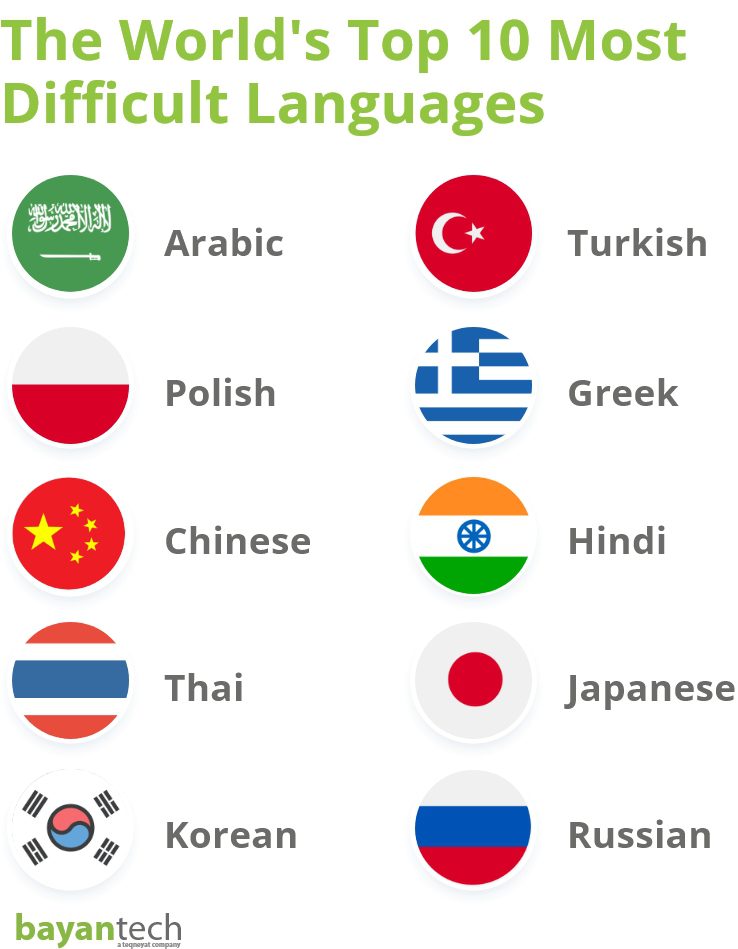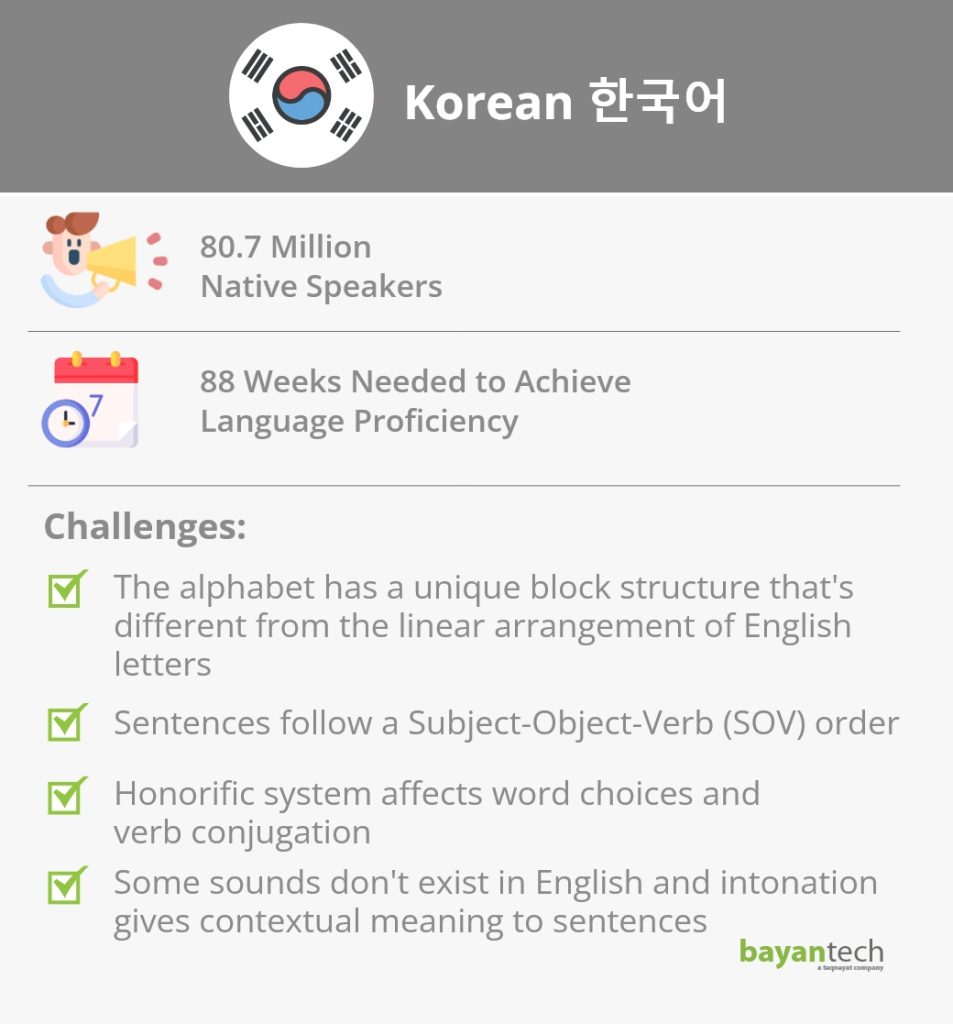Have you ever tried learning a new language, only to find yourself struggling with its challenges? Learning a foreign language is indeed a tough journey. Or as the saying goes it’s like learning to swim by being thrown in the deep end.
But do all languages share the same difficulty level or are some languages easier to master than others? Well, some languages are definitely more challenging, even for the most dedicated language enthusiasts. This might be due to their unique phonetics, writing system, or complex grammar rules.
So, what are the hardest languages to learn then? In this article, we’ll dive into the world’s hardest languages to learn and explore what makes them so challenging, especially for English speakers.
If you love a challenge, keep reading to uncover the secrets of the world’s toughest languages and the reasons behind their complexity!
First, Let’s Discuss What Makes a Language Difficult to Learn
How you perceive a language’s difficulty depends greatly on your linguistic background and can be influenced by several factors. In other words, different people can have different opinions about which languages are difficult, and that’s because their experiences and native languages aren’t the same.
For example, if you speak English and you’re trying to learn Persian (Farsi). You might find the alphabet really challenging because the writing system is unfamiliar and the letters look very different from English.
However, if you’re a native Arabic speaker, learning to read and write Persian might not be as difficult. That’s because Persian and Arabic share similar writing systems, as the Persian alphabet is derived from the Arabic script. Keep in mind, though, that Arabic speakers may still face other challenges while learning Persian, such as grammar or pronunciation.
So, which factors often make learning a new language challenging?
- Phonetics (42% of language learners find pronunciation the most challenging aspect)
- Writing Systems
- Vocabulary (53% struggle with acquiring new vocabulary)
- Cultural Understanding
- Grammar Rules (68% of learners struggle with grammar)
The Top 10 Hardest Languages in the World
Did you know that some of the world’s most widely spoken native languages also rank among the hardest languages to learn? It’s fascinating to think about the challenges and opportunities that come with studying these languages.
Mastering these languages, despite their difficulty, provides you with the incredible rewards of understanding and communicating with a significant portion of the world’s population, each with its one-of-a-kind culture and special traditions.
So, here’s a quick glance at the world’s toughest languages to learn (in no particular order).
Curious to explore the most difficult languages in-depth? Keep reading to uncover the unique characteristics of the world’s hardest languages to learn!
What Are the Hardest Languages to Learn for English Speakers?
As we’ve said earlier, a language’s difficulty level is a subjective matter. However, the Foreign Service Institute (FSI) has categorized languages based on their difficulty for native English speakers.
In this section, we’ll explore the languages the FSI classifies as “Category V“, meaning they are “exceptionally difficult”. The FSI also estimates that it takes about 2200 hours to be proficient in these languages.
So, let’s uncover the top four languages one by one!
1. Chinese
Chinese is one of the most widely spoken languages worldwide, with more than 1.3 billion native speakers, including 955 million Mandarin speakers and 70 million Cantonese speakers. And Chinese also stands at the top of the list when it comes to the hardest languages to learn. Let’s explore why!
- Logographic Writing System
The Chinese writing system is unique and very different from the Latin alphabet. Instead of using letters, the Chinese language consists of thousands of characters and symbols that represent specific meanings.
Compared to English and European languages that use Latin letters, memorizing all Chinese characters and their meanings can be very difficult. Besides, the way characters are written is very specific, with a certain stroke order and direction which can be challenging for beginners.
- Diverse Language Groups
Chinese consists of 7 to 10 main dialects, and each language family contains numerous sub-dialects. However, these dialects are not mutually intelligible, meaning speakers of one may not understand those of another. This diversity poses a challenge for language learners, as the choice of dialect greatly affects their ability to communicate with Chinese speakers from different regions.
- Tonal Nature
The tonal nature of Chinese adds another layer of complexity. In Chinese, the pitch of your voice when you pronounce a word can change its meaning entirely. For instance, in Mandarin Chinese, there are four tones. So, for example, the word “shì” can mean “poetry”, “to be”, “history”, or “time”, depending on how you pronounce it.
2. Arabic
Arabic, spoken by over 372 million people as their first language, ranks second in the hardest languages to learn for English speakers. Here’s why:
- Right-to-Left Writing
First, Arabic is written from right to left, and the letters’ shape changes depending on their position within a word (initial, medial, or final). This combination of right-to-left writing and the cursive nature of Arabic script can make reading and writing Arabic difficult for English speakers.
- More Than 20 Regional Dialects
Arabic has many dialect variations that differ from Modern Standard Arabic (MSA). While different Arabic dialects share some similarities, each one still has its unique vocabulary and pronunciation that speakers of other dialects might not always understand.
For example, the word “yogurt” translates to “laban – لبن”, in MSA. However, in the Egyptian dialect, “laban” refers to milk, while yogurt is called “zebadi – زبادي.” Meanwhile, in other parts of North Africa, yogurt is known as “raïb – رايب.”
- Unique Phonetics
Another challenging aspect is Arabic phonetics. Arabic has several sounds that don’t exist in English and can be very difficult to pronounce, such as the “ع – Ayn”, “غ – Ghayn”, and “ض – Ḍād”.
- Grammatical Challenges
The sentence structure in Arabic is different, following a Verb-Subject-Object order, unlike the Subject-Verb-Object (SVO) structure in English. For example, “The boy ate the apple” in English translates to (أكل الولد التفاحة) “Ate the boy the apple” in Arabic.
Also, Arabic verbs take different forms depending on whether the subject is singular, dual (referring to two people/things), or plural. Additionally, verbs are conjugated differently for masculine and feminine subjects. Of course, this complex verb conjugation system can be challenging for English speakers.
3. Japanese
Japanese ranks third on our list of the hardest languages for English speakers to learn. Despite its different layers of complexity, learning Japanese can be a fun journey for those who enjoy new challenges. Let’s explore why!
- Three Writing Systems
The Japanese writing system is very unique. Japanese has three different alphabets, Kanji (borrowed from Chinese characters), Hiragana, and Katakana. In a typical Japanese sentence, you will find a mix of all three scripts. Kanji is used for the main content words like nouns and verbs, Hiragana is used for grammatical elements, particles, and native Japanese words, and Katakana is used for loanwords and foreign names.
- Honorific Speech
Japanese has a complex system of honorific speech “Keigo,” used to show respect and humility in social interactions. However, this is not just a matter of etiquette – it’s grammatically encoded in the language, affecting verb conjugations and choice of words. Mastering Japanese formality levels requires a deep understanding of the Japanese cultural norms and social hierarchy.
- Pitch Accent
Japanese has a pitch accent system, where the meaning of a word can change based on the pitch pattern of its syllables. For example, the word “Kami – かみ” can mean “hair,” “paper,” or “god,” depending on the intonation. English speakers may struggle to hear and produce these intonation differences accurately.
- Sentence Structure
Japanese typically follows a Subject-Object-Verb (SOV) order. So, the English sentence “I eat sushi” would translate to “Watashi wa sushi o tabemasu” (I sushi eat) in Japanese.
4. Korean
Although Korean ranks last on our list of the hardest languages to learn, with a smaller native-speaking population of 80 million people, it still opens the door for language learners to a whole different culture with its unique quirks and fascinating history.
- Alphabet
While the Korean alphabet “Hangul” is relatively simple compared to Chinese and Japanese, it can still be quite challenging for beginners. Hangul consists of 24 letters, including 14 consonants and 10 vowels. However, the main difficulty lies in Hangul’s unique block structure, where letters are grouped into syllabic blocks.
Each syllabic block contains two to four letters, including at least one consonant and one vowel. These blocks are written in a square-like format, with the letters arranged vertically or horizontally depending on the vowel’s position. This structure is very different from the linear arrangement of letters in English.
- Grammar and Formality Levels
Similar to Japanese, Korean sentences also follow a Subject-Object-Verb (SOV) order. Additionally, formality levels exist in Korean, which means that the words, pronouns, and even vocabulary take different forms depending on the person you’re speaking with, your relationship with them, and their social status. The Korean honorific system can be complex for English speakers since it requires a profound grasp of Korean culture and social hierarchy.
- Pronunciation
Additionally, some consonants and vowels in Korean represent sounds that do not exist in English which can be difficult to produce and distinguish. Furthermore, the pitch in Korean pronunciations is also an important factor that adds emotional or contextual meaning to a sentence. Sentence intonation can generally rise and fall in ways that are unfamiliar to English speakers, and getting this right is key to sounding natural.
bayantech: Your Gateway to Cross Cultural Communication
Are your communications held back by language barriers? Don’t let the complexities of foreign languages hinder your ability to communicate and connect with clients or business partners abroad! Our professional translation services can help unlock new opportunities for your business.
Located in the heart of the MENa region, bayantech is a leading provider of Arabic translation services in addition to +185 other languages including all African and major Asian and European languages. We help business owners overcome cultural and language barriers throughout their journey in foreign markets.
Get in touch today and learn how our solutions can streamline your international communication and drive your business forward!
8 Steps Every Medical Interpreter Takes
Looking for a medical interpreter? Discover the career path of medical interpreters and qualifications they need to acquire to take on interpreting jobs.














